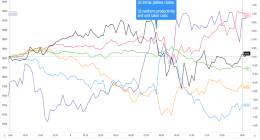
There’s overwhelming evidence that walking lowers the risk of Type 2 diabetes, along with other diseases like cancer, heart disease and dementia.
The American Diabetes Association recommends taking 10,000 steps per day or walking daily for at least 30 minutes to reduce your diabetes risk.
Walking at a faster pace can improve that benefit, but researchers haven’t identified an ideal speed — until now.
An analysis published Tuesday in the British Journal of Sports Medicine suggests that, independent of distance or step count, walking at least 2.5 mph can significantly lower the risk of developing Type 2 diabetes. That’s the equivalent of a brisk walk — around 87 steps per minute for men and 100 steps per minute for women.
Once people meet that threshold, their risk continues to decline as they increase their speed, according to the research. Every 0.6 mph increase in walking speed in the analysis was associated with a 9% lower risk of Type 2 diabetes.
The analysis pooled the results of 10 studies involving more than 500,000 people from the U.S., Japan and the U.K. who reported their walking habits. Those with an average walking pace — 2 to 3 mph— had a 15% lower risk of Type 2 diabetes compared with people who walked at a slower pace, akin to a stroll.
Brisk walking (3–4 mph) was associated with a 24% lower risk of Type 2 diabetes, while striding (more than 4 mph) was associated with a 39% reduced risk.
“While current strategies to increase walking time and to increase steps per day may be a good approach to reduce the risk of Type 2 diabetes, it’s also better to encourage people to walk at faster speeds,” said Ahmad Jayedi, the study’s lead author and a nutrition researcher at Semnan University of Medical Sciences in Iran.
Brisk walking can reduce body fat, which in turn lowers the risk of Type 2 diabetes. But Jayedi said reductions in body fat didn’t fully explain the lower diabetes risk among participants in his analysis.
He said that walking at faster speeds also helps lower insulin resistance — or a built-up tolerance to insulin, a hormone that helps regulate blood sugar levels.
“Increasing the walking pace not only increases your heart rate but also increases your muscle contractions. That can help improve insulin sensitivity, which is very important for the prevention of diabetes,” said Dr. Frank Hu, chair of the nutrition department at the Harvard T.H. Chan School of Public Health, who wasn’t part of the analysis.
In general, the Department of Health and Human Services recommends that people get 150 to 300 minutes per week of moderate physical activity like a brisk walk or bike ride, 75 to 150 minutes per week of vigorous physical activity like jogging or running, or some combination.
Walking at least 2.5 mph “might be a good goal for some people to reach for in terms of getting to that moderate intensity activity,” said Amanda Paluch, an epidemiologist and kinesiologist at the University of Massachusetts Amherst, who wasn’t involved in the research.
However, that speed might be difficult to achieve for some people, depending on their age, fitness level and health status, she said. A better rule of thumb, Paluch said, is to walk at a pace where you’re able to talk but can’t sing the words to your favorite song — a sign that your heart rate is sufficiently elevated.
According to Jochen Kressler, a professor of exercise and nutritional sciences at San Diego State University, people may still be able to reduce their risk of Type 2 diabetes at speeds below 2.5 mph. The new analysis didn’t examine whether slow walking reduced the risk of diabetes compared to no walking at all, he said.
“Don’t take this as, ‘If you’re not walking fast enough, it’s not working.’ That’s definitely not what’s in this paper. To do something is better than nothing,” said Kressler, who also wasn’t involved in the new research.
Researchers tend to see the biggest improvements in health outcomes when people with the lowest activity levels start to increase their movement, he said. And the amount of exercise is usually the most crucial, he added.
“How many steps you do is probably more important than how fast you do them,” Kressler said. “But if you walk faster at the same number of steps, it’s going to be better.”
Source: | This article originally belongs to Nbcnews.com










